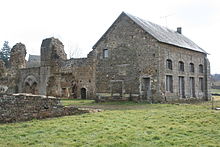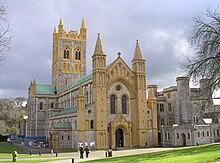Congregation of Savigny

The
in France.Founding
Vitalis was a
The number of disciples who then gathered around him necessitated the construction of adequate buildings, in which was instituted the monastic life, following the
Expansion

The Congregation founded daughter-houses such as that at

Under Geoffroy, successor to Vitalis, Henry I of England, established and generously endowed twenty-nine monasteries of this Congregation in his dominions.[4] Early in the 12th century, Buckfast Abbey was incorporated into the Benedictine Congregation of Savigny.[5] The monasteries of Basingwerk (Flintshire) and Neath (Glamorgan) in Wales were founded as Savigniac houses, as was Combermere Abbey. St. Mary's Abbey, Dublin was founded as a Benedictine house in 862, and given to the Congregation of Savigny in 1139.[6] From the number of its foundations Savigny became the head of a Congregation, numbering thirty-three subordinate houses, within thirty years of its own inception.
Administrative merger with the Cistercians
By 1147, the Order was experiencing financial and administrative difficulties. Abbot Serlo, third successor of the founder, found it difficult to retain his jurisdiction over the English monasteries, who wished to make themselves independent. He determined to affiliate the entire Congregation to
Later history
The Savigny Abbey continued to exist until the Revolution reduced it to a heap of ruins, and scattered its then existing members. Of all its former dependencies only
Saints
Notes
- ^ Webster, Douglas Raymund. "St. Vitalis of Savigny." The Catholic Encyclopedia Vol. 15. New York: Robert Appleton Company, 1912]
- ISBN 9780879077587
- ^ Hind, George. "Furness Abbey." The Catholic Encyclopedia Vol. 6. New York: Robert Appleton Company, 1909. 11 September 2022
- ^ a b Obrecht, Edmond. "Abbey of Savigny." The Catholic Encyclopedia. Vol. 13. New York: Robert Appleton Company, 1912. 31 Jan. 2015
- ^ Hunter-Blair, Oswald. "Buckfast Abbey." The Catholic Encyclopedia. Vol. 3. New York: Robert Appleton Company, 1908. 31 Jan. 2015
- ^ Peter, A. (1927). Dublin Fragments: Social and Historic. Dublin: Hodges Figgis & Co.
References
- Anthony New. A Guide to the Abbeys of England And Wales. Constable.
